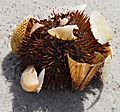Cayo Costa State Park facts for kids
Quick facts for kids Cayo Costa State Park |
|
|---|---|
|
IUCN Category IV (Habitat/Species Management Area)
|
|
| Location | Lee County, Florida, United States |
| Nearest city | Boca Grande, Florida |
| Area | 2,506 acres (10 km2) |
| Governing body | Florida Department of Environmental Protection |
Cayo Costa State Park is a special park in Florida, USA. It's on Cayo Costa, an island near Boca Grande, Florida and North Captiva Island. This beautiful park is about 12 miles (19 km) west of Cape Coral, Florida.
You can only reach Cayo Costa State Park by boat or helicopter. This makes it a truly unique and peaceful place to visit!
Contents
Island History
Cayo Costa was once home to the Calusa people, a Native American tribe. They lived there until about the year 1700. You can still find shell mounds they built on the island.
Later, in the 1700s, fishermen from Cuba set up ranchos (fishing camps) along Florida's coast. They used these camps to catch and prepare fish to sell in Havana. Cayo Costa might have been one of these important fishing spots.
Captain Pappy's Rancho
In the late 1800s, a man named Tervio Padilla, also known as "Captain Pappy," settled on Cayo Costa. He was from the Canary Islands and became a U.S. citizen. Captain Pappy ran a fishing camp where he and his workers caught and processed fish for the Cuban market.
There's a cemetery on the island where Captain Pappy and his wife are buried. About 30 Cuban fishermen who died in a hurricane in 1910 are also buried there.
Island Geography
Cayo Costa Island is part of a chain of barrier islands. These islands protect Charlotte Harbor and Pine Island Sound from the open ocean.
The park has nine miles (14 km) of soft, white sandy beaches. It also has 2,506 acres (1,014 ha) of pine forests. You'll find oak-palm hammocks (small groups of trees) and mangrove swamps too.
Amazing Animals
Many different animals live in Cayo Costa State Park. It's a great place to see wildlife!
Sea Turtles
One of the most exciting animals to see here are sea turtles. Four types of sea turtles visit the island:
- The loggerhead (Caretta caretta)
- The hawksbill (Eremochelys imbriata)
- The green (Chelonia mydas)
- The Kemp's ridley (Lepidochelys kempii)
Cayo Costa is a very important place for sea turtles to lay their eggs. Many volunteers check the beaches every morning from March to October. They look for nests and protect them. Loggerhead turtles lay the most eggs here, followed by green turtles.
Other Wildlife
You might also spot common raccoons (Procyon lotor) on the island. Raccoons sometimes try to eat sea turtle eggs. Other animals like foxes, ants, and ghost crabs can also be a threat to the eggs.
The West Indian manatee (Trichechus manatus) is another special animal found near the island. These gentle giants are an endangered species, but their numbers are slowly growing. You can often see them swimming near the beaches or docks.
Bottlenose dolphins (Tursiops truncates) love to play and swim along the island's nine miles of beaches. Keep an eye out for them jumping!
You'll also see Snowy egrets (Egretta thula). These small white birds have long black legs and yellow feet. They usually stay close to the beaches.
The southern bald eagle (Haliaeetus leucocephalus) can be seen flying high above the island. These large birds are also a threatened species. They mostly eat fish and are amazing to watch.
Interesting Plants
Cayo Costa State Park has many unique plants.
Mother-in-law's Tongue
The mother-in-law's tongue (Sansevieria trifasciata) grows in the park. This plant is often kept as a houseplant, but here it's an invasive species. It spread from old houses on the island. Park staff are working to remove it.
Resurrection Fern
The resurrection fern (Pleopeltis polypodioides) grows on trees all over Cayo Costa. This fern is special because it looks brown and dry when it needs water. But when it rains, it quickly turns green and looks alive again!
Seagrape
Seagrape (Coccoloba uvifera) plants are common at Cayo Costa. Their fruit grows in the summer. It starts green and turns purplish when ripe. Locals sometimes make jellies or wines from these grapes. Seagrape plants can grow very tall and are often found near the ocean because they can handle salty conditions.
Fun Activities
There are many fun things to do at Cayo Costa State Park:
- Hiking on trails
- Off-road bicycling
- Swimming in the ocean
- Kayaking
- Snorkeling
- Picnicking
- Fishing
- Shelling (collecting shells)
- Watching wildlife
- Camping
- Sunbathing
Park Amenities
The park has many things to make your visit comfortable:
- Boat slips for docking your boat
- Beautiful beaches
- Hiking trails
- Picnic pavilions
- 12 simple camping cabins
- Bath houses and restrooms
There's also a small nature center and gift shop. You can learn about nature and buy things like ice, sunscreen, bug spray, T-shirts, and postcards. You can even rent bikes for half a day or a full day!
Camping at Cayo Costa
If you want to stay overnight, there are 12 primitive cabins and 30 tent sites. Each camping spot has a picnic table and a fire pit or grill. If you come by boat, you can also camp aboard your boat at the slips.
Florida state parks are open every day of the year, from 8 AM until sundown.
Wildlife gallery






